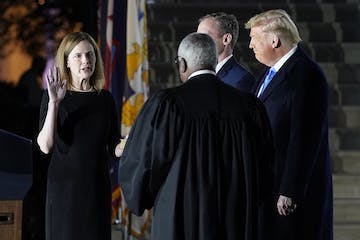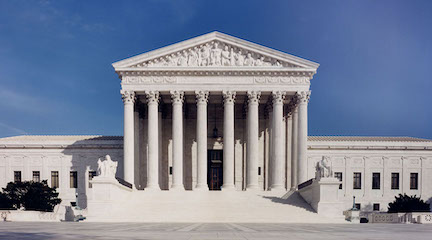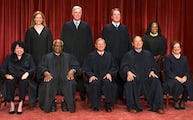Welcome

The death of Justice Antonin Scalia in February of 2016 shook the Republican Party. With President Obama provided
an opportunity to add a justice likely to join more often with the liberal bloc of four, the Republican Supreme Court
agenda was in peril.
What had eluded the Republicans since the presidency of Richard Nixon was the creation of a reliable conservative
majority on the Court. Three of Nixon’s four appointees (Burger, Blackmun, and Powell) were in the majority in the
7-2 Roe v. Wade (1973) decision. Roe was a straw breaking the camel’s back, touching on an issue that accelerated
the convergence of Republican partisanship with conservative ideology and initiated a concerted effort to gain control
of the judiciary. 
 Senator Jeremiah Denton’s (R-AL) grilling of Sandra Day O’Connor, the first woman nominated for the
Court in 1981, regarding her position on Roe and on abortion, created a thread that would weave through every
subsequent confirmation hearing for the next 40 years. Simultaneously, a conservative think tank, the Free Congress
Foundation, published a Blueprint for Judicial Reform, and in 1982 the Federalist Society was created. The goal was
nothing short of a federal judiciary dominated by an ideologically conservative jurisprudence.
Senator Jeremiah Denton’s (R-AL) grilling of Sandra Day O’Connor, the first woman nominated for the
Court in 1981, regarding her position on Roe and on abortion, created a thread that would weave through every
subsequent confirmation hearing for the next 40 years. Simultaneously, a conservative think tank, the Free Congress
Foundation, published a Blueprint for Judicial Reform, and in 1982 the Federalist Society was created. The goal was
nothing short of a federal judiciary dominated by an ideologically conservative jurisprudence.
By 2016, Republican presidents had 12 opportunities to fill vacancies compared to only four for Democratic presidents.
The result was a conservative bloc of five, identifiable as early as 1988, although too often there seemed to be one justice who
would join with the liberal bloc of four to produce key outcomes not preferred by the Republicans, especially involving the
overturning of Roe v. Wade.


Senate Majority Leader Mitch McConnell didn’t hesitate. With full backing of Senate Republicans, President Obama’s
mid-March nomination of Judge Merrick Garland was stonewalled. The Senate would not even consider the nomination.
Seeking to justify this blatant, yet legitimate, use of partisan political power, McConnell stated that we should “let the
American people decide.” No nomination would be considered during a presidential election year.
 Make no mistake, Supreme Court appointments are always political, and both sides know how to play the game.
But the Republicans were prepared and positioned to fully implement their end-justifies-the-means politics. The
payoff for McConnell’s action was immediate. Donald Trump was elected president, the Republicans retained control
of the Senate, and Neil Gorsuch, a textualist in the mold of Scalia, so it was thought, was nominated and confirmed
to the Court. All it took was for the Republicans to eliminate the filibuster for Supreme Court confirmations to allow
a simple majority to prevail. McConnell, of course, never acknowledged that the American people, at least those who
voted, actually preferred Hillary Clinton as the one who would make judicial nominations.
Make no mistake, Supreme Court appointments are always political, and both sides know how to play the game.
But the Republicans were prepared and positioned to fully implement their end-justifies-the-means politics. The
payoff for McConnell’s action was immediate. Donald Trump was elected president, the Republicans retained control
of the Senate, and Neil Gorsuch, a textualist in the mold of Scalia, so it was thought, was nominated and confirmed
to the Court. All it took was for the Republicans to eliminate the filibuster for Supreme Court confirmations to allow
a simple majority to prevail. McConnell, of course, never acknowledged that the American people, at least those who
voted, actually preferred Hillary Clinton as the one who would make judicial nominations.
 McConnell’s gambit was about to pay off in spades. In 2018, Justice Anthony Kennedy retired. While siding with
the conservatives more often than not, he was the quintessential median justice, voting with the liberal bloc on a
number of key issues. In the previous decade, 105 cases had been decided by 5-4 votes pitting the conservative
and liberal blocs in opposition. The conservative bloc prevailed in 58 of those cases, Kennedy joining in 57 of them.
Of the 45 cases with the liberal bloc in the majority, 38 of them were because of Kennedy’s supporting vote. Finally,
Republicans could acquire their holy grail of a steadfast conservative bloc, and they sought to achieve that with the
nomination and confirmation of Brett Kavanaugh.
McConnell’s gambit was about to pay off in spades. In 2018, Justice Anthony Kennedy retired. While siding with
the conservatives more often than not, he was the quintessential median justice, voting with the liberal bloc on a
number of key issues. In the previous decade, 105 cases had been decided by 5-4 votes pitting the conservative
and liberal blocs in opposition. The conservative bloc prevailed in 58 of those cases, Kennedy joining in 57 of them.
Of the 45 cases with the liberal bloc in the majority, 38 of them were because of Kennedy’s supporting vote. Finally,
Republicans could acquire their holy grail of a steadfast conservative bloc, and they sought to achieve that with the
nomination and confirmation of Brett Kavanaugh.
The Kavanaugh nomination was roundly criticized by the media and the senators themselves as being an especially
nasty affair,  but given the stakes, the recent change in Senate rules for confirmation, and the vulnerability of the
nominee, one should not be surprised or even dismayed by the political goings-on.
Indeed, one could argue the
Democrats were simply too nice, failing to go for the jugular. What they needed was a
smack-down along the lines
of Senator Ted Kennedy in the Robert Bork nomination of 1987. What makes the actions of one side appear so bad
is the rhetoric of the other side portraying it that way.
but given the stakes, the recent change in Senate rules for confirmation, and the vulnerability of the
nominee, one should not be surprised or even dismayed by the political goings-on.
Indeed, one could argue the
Democrats were simply too nice, failing to go for the jugular. What they needed was a
smack-down along the lines
of Senator Ted Kennedy in the Robert Bork nomination of 1987. What makes the actions of one side appear so bad
is the rhetoric of the other side portraying it that way.
Still, nagging doubts had surfaced regarding the reliability of Chief Justice Roberts as a conservative stalwart.
 So,
when Justice Ginsburg died just six weeks before the 2020 general election, Republicans seized the opportunity to
cement the conservative bloc with a sixth presence. The nomination would be the closest to a presidential election in
history, but getting it done before the election could prove valuable in post-election and other matters before the Court.
It took some political casuistry to rationalize not “letting the American people decide,” but the president opted for a
former Scalia-clerk and self-proclaimed originalist and textualist, Amy Barrett. She was confirmed in about half the time
normally allotted for the process. So,
when Justice Ginsburg died just six weeks before the 2020 general election, Republicans seized the opportunity to
cement the conservative bloc with a sixth presence. The nomination would be the closest to a presidential election in
history, but getting it done before the election could prove valuable in post-election and other matters before the Court.
It took some political casuistry to rationalize not “letting the American people decide,” but the president opted for a
former Scalia-clerk and self-proclaimed originalist and textualist, Amy Barrett. She was confirmed in about half the time
normally allotted for the process.
What the future holds for the Supreme Court remains to be seen.  Democrats put a lot of pressure on Justice Breyer
to retire, not wanting a replay of the Ginsburg scenario. He complied with an early 2022 announcement that he would
retire at the end of the current Court session, though only if a successor had been approved. The subsequent historic
Biden nomination of Katanji Brown Jackson, a former Breyer clerk, has replenished the liberal bloc of three. Beyond that,
no vacancy is expected for some time. Check The Vacancy page for a look at the potential for vacancies.
Democrats put a lot of pressure on Justice Breyer
to retire, not wanting a replay of the Ginsburg scenario. He complied with an early 2022 announcement that he would
retire at the end of the current Court session, though only if a successor had been approved. The subsequent historic
Biden nomination of Katanji Brown Jackson, a former Breyer clerk, has replenished the liberal bloc of three. Beyond that,
no vacancy is expected for some time. Check The Vacancy page for a look at the potential for vacancies.
This site has been created to help citizens, students, journalists,
academics, and politicians alike understand and anticipate the Supreme
Court appointment process as it unfolds. The links to the left walk
you through the different stages of the vacancy, nomination, and confirmation
processes. Click on the Vacancy link for an exploration of motivations in retiring or
not retiring. Go to the President page for a look at how presidents address
vacancies and subsequent nominations. Please feel free to make suggestions about how this site
can better serve any of you by submitting comments from the FAQS
page. Also, consult the FAQs page for answers about questions involving
the current situation. Substantial changes and additions will be made
to this site now that two vacancies on the Court have occurred. Please
check back periodically for new information.
Last update for this page: October 23, 2022, by GW |






 Senator Jeremiah Denton’s (R-AL) grilling of Sandra Day O’Connor, the first woman nominated for the
Court in 1981, regarding her position on Roe and on abortion, created a thread that would weave through every
subsequent confirmation hearing for the next 40 years. Simultaneously, a conservative think tank, the Free Congress
Foundation, published a Blueprint for Judicial Reform, and in 1982 the Federalist Society was created. The goal was
nothing short of a federal judiciary dominated by an ideologically conservative jurisprudence.
Senator Jeremiah Denton’s (R-AL) grilling of Sandra Day O’Connor, the first woman nominated for the
Court in 1981, regarding her position on Roe and on abortion, created a thread that would weave through every
subsequent confirmation hearing for the next 40 years. Simultaneously, a conservative think tank, the Free Congress
Foundation, published a Blueprint for Judicial Reform, and in 1982 the Federalist Society was created. The goal was
nothing short of a federal judiciary dominated by an ideologically conservative jurisprudence.  Make no mistake, Supreme Court appointments are always political, and both sides know how to play the game.
But the Republicans were prepared and positioned to fully implement their end-justifies-the-means politics. The
payoff for McConnell’s action was immediate. Donald Trump was elected president, the Republicans retained control
of the Senate, and Neil Gorsuch, a textualist in the mold of Scalia, so it was thought, was nominated and confirmed
to the Court. All it took was for the Republicans to eliminate the filibuster for Supreme Court confirmations to allow
a simple majority to prevail. McConnell, of course, never acknowledged that the American people, at least those who
voted, actually preferred Hillary Clinton as the one who would make judicial nominations.
Make no mistake, Supreme Court appointments are always political, and both sides know how to play the game.
But the Republicans were prepared and positioned to fully implement their end-justifies-the-means politics. The
payoff for McConnell’s action was immediate. Donald Trump was elected president, the Republicans retained control
of the Senate, and Neil Gorsuch, a textualist in the mold of Scalia, so it was thought, was nominated and confirmed
to the Court. All it took was for the Republicans to eliminate the filibuster for Supreme Court confirmations to allow
a simple majority to prevail. McConnell, of course, never acknowledged that the American people, at least those who
voted, actually preferred Hillary Clinton as the one who would make judicial nominations. McConnell’s gambit was about to pay off in spades. In 2018, Justice Anthony Kennedy retired. While siding with
the conservatives more often than not, he was the quintessential median justice, voting with the liberal bloc on a
number of key issues. In the previous decade, 105 cases had been decided by 5-4 votes pitting the conservative
and liberal blocs in opposition. The conservative bloc prevailed in 58 of those cases, Kennedy joining in 57 of them.
Of the 45 cases with the liberal bloc in the majority, 38 of them were because of Kennedy’s supporting vote. Finally,
Republicans could acquire their holy grail of a steadfast conservative bloc, and they sought to achieve that with the
nomination and confirmation of Brett Kavanaugh.
McConnell’s gambit was about to pay off in spades. In 2018, Justice Anthony Kennedy retired. While siding with
the conservatives more often than not, he was the quintessential median justice, voting with the liberal bloc on a
number of key issues. In the previous decade, 105 cases had been decided by 5-4 votes pitting the conservative
and liberal blocs in opposition. The conservative bloc prevailed in 58 of those cases, Kennedy joining in 57 of them.
Of the 45 cases with the liberal bloc in the majority, 38 of them were because of Kennedy’s supporting vote. Finally,
Republicans could acquire their holy grail of a steadfast conservative bloc, and they sought to achieve that with the
nomination and confirmation of Brett Kavanaugh. but given the stakes, the recent change in Senate rules for confirmation, and the vulnerability of the
nominee, one should not be surprised or even dismayed by the political goings-on.
Indeed, one could argue the
Democrats were simply too nice, failing to go for the jugular. What they needed was a
but given the stakes, the recent change in Senate rules for confirmation, and the vulnerability of the
nominee, one should not be surprised or even dismayed by the political goings-on.
Indeed, one could argue the
Democrats were simply too nice, failing to go for the jugular. What they needed was a
 So,
when Justice Ginsburg died just six weeks before the 2020 general election, Republicans seized the opportunity to
cement the conservative bloc with a sixth presence. The nomination would be the closest to a presidential election in
history, but getting it done before the election could prove valuable in post-election and other matters before the Court.
It took some political casuistry to rationalize not “letting the American people decide,” but the president opted for a
former Scalia-clerk and self-proclaimed originalist and textualist, Amy Barrett. She was confirmed in about half the time
normally allotted for the process.
So,
when Justice Ginsburg died just six weeks before the 2020 general election, Republicans seized the opportunity to
cement the conservative bloc with a sixth presence. The nomination would be the closest to a presidential election in
history, but getting it done before the election could prove valuable in post-election and other matters before the Court.
It took some political casuistry to rationalize not “letting the American people decide,” but the president opted for a
former Scalia-clerk and self-proclaimed originalist and textualist, Amy Barrett. She was confirmed in about half the time
normally allotted for the process.  Democrats put a lot of pressure on Justice Breyer
to retire, not wanting a replay of the Ginsburg scenario. He complied with an early 2022 announcement that he would
retire at the end of the current Court session, though only if a successor had been approved. The subsequent historic
Biden nomination of Katanji Brown Jackson, a former Breyer clerk, has replenished the liberal bloc of three. Beyond that,
no vacancy is expected for some time. Check
Democrats put a lot of pressure on Justice Breyer
to retire, not wanting a replay of the Ginsburg scenario. He complied with an early 2022 announcement that he would
retire at the end of the current Court session, though only if a successor had been approved. The subsequent historic
Biden nomination of Katanji Brown Jackson, a former Breyer clerk, has replenished the liberal bloc of three. Beyond that,
no vacancy is expected for some time. Check